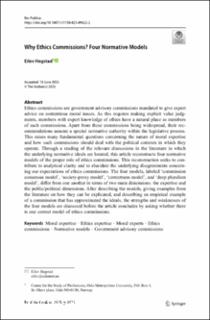| dc.description.abstract | Ethics commissions are government advisory commissions mandated to give expert
advice on contentious moral issues. As this requires making explicit value judg-
ments, members with expert knowledge of ethics have a natural place as members
of such commissions. Apart from these commissions being widespread, their rec-
ommendations assume a special normative authority within the legislative process.
This raises many fundamental questions concerning the nature of moral expertise
and how such commissions should deal with the political contexts in which they
operate. Through a reading of the relevant discussions in the literature in which
the underlying normative ideals are located, this article reconstructs four normative
models of the proper role of ethics commissions. This reconstruction seeks to con-
tribute to analytical clarity and to elucidate the underlying disagreements concern-
ing our expectations of ethics commissions. The four models, labeled ‘commission
consensus model’, ‘society-proxy model’, ‘correctness model’, and ‘deep pluralism
model’, differ from one another in terms of two main dimensions: the expertise and
the public/political dimensions. After describing the models, giving examples from
the literature on how they can be explicated, and describing an empirical example
of a commission that has approximated the ideals, the strengths and weaknesses of
the four models are discussed before the article concludes by asking whether there
is one correct model of ethics commissions. | en_US |

